Beyond Brands: Twist-rates, Lengths, Gas Systems – and Function

Last September a friend called seeking some advice about how to choose a .300 Blackout barrel and the many .300 options in general. He was considering the purchase of a spare upper receiver for his AR-15. I assumed his interest involved suppressors, but assumptions can get you in trouble.
As it turned out, he was really just after a light-kicking deer rifle for his 12-year-old son. And, in my sporting circle, he wasn’t alone. The .300 Blackout is pretty much synonymous with the AR -15 and suppressors, but barrels in this caliber are also attached to other actions capable of handling the ubiquitous 5.56 NATO/.223 Remington. My son has plenty of whitetail experience and owns several classic deer rifles, but his Kimber Model 84 Adirondack bolt-action has chalked up several good bucks.
Smaller and handier than the .300 Blk AR in his safe, this demure rifle also doubles as his deep-woods predator rifle. Both have threaded muzzles, but a suppressor isn’t even on his radar screen. Virtually all of his shooting involves supersonic loads – which tie in nicely with AAC’s connection.
.300 Blackout Background
As offered by AAC, the .300 Blackout is an incarnation of the older J.D. Jones-designed “Whisper.” Cases can be formed from shortened 5.56mm/.223 brass, but the Whisper was actually created by necking up the .221 Fireball (see my article on converting 5.56 brass to .300).
The original idea (marketed by SSK) was to offer a quiet .30 cartridge capable of cycling an AR-15 via heavy subsonic bullets of 200 grains or more. When fired through a suppressor, the result was a very quiet rifle. AAC’s newer version, the .300 Blackout, was tweaked to incorporate lightweight supersonics of 110-125 grains capable of reaching around 2300 fps.
Recoil is negligible, and performance is roughly on par with the 7.62×39 Russian. The .300 Blk quickly caught on, to include firearms beyond the AR-15, but the AR is a natural for this caliber. Today’s options include completed carbine or pistol versions, along with drop-on upper-receiver assemblies.
Of interest to “builders”, a .300 BLK AR-15 conversion requires nothing more than a new barrel. With proper head-spacing, everything else should be good to go.
Special Needs Cartridge?
Still, the .300 Blackout is an odd duck. Tasked with disparate velocities and pressures, reliable function can pose challenges for gas-operated systems – a non-issue for others. If my son springs for a suppressor, his manually operated bolt-gun will digest pretty much anything in the Blackout’s repertoire.
Same for two affordable and handy break-action CVA single-shots in my custody. As a sidenote, these rifles are quieter when suppressed and immune to the ejection-port blasts common to some AR gas systems. But the Blackout will still run well in a properly built AR-15, to include several I’ve been using.
Before proceeding though, a disclaimer: I’ve been using Stoner’s system for five-plus decades (to include development of the .300 Blackout for a major AR manufacturer), but I still don’t consider myself a true AR Guru. When it comes to gas systems, buffers, and even “builds”, I rely on the expertise of the same factory-trained armorer that kept my agency’s sizeable AR-15 inventory running.
The nuances of .300 Blk gas systems, buffers and barrel lengths only complicate matters so, instead, I’ll focus on a part that effects downrange results: The .300 Blackout barrel. Meanwhile, for insight on pressure-related factors to include dwell time, this link should prove educational: What is AR-15 “Dwell Time”?
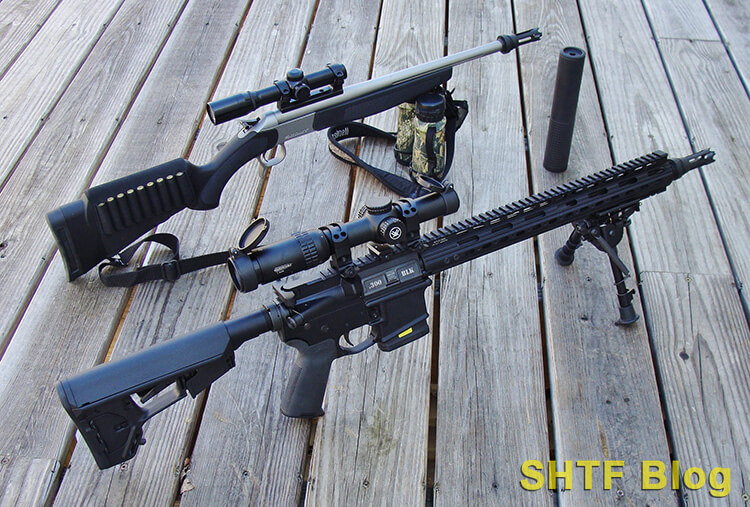
Consider the Use Factors
Off the top of my head, I count three main categories of Blackout shooters…
Supersonic Shooters
This crowd has little-to-no interest in suppressors (AKA silencers). For them, the main attractions are the Blackout’s mild report, gentle recoil, and its extra .30-caliber punch (compared to a 5.56/.223). This group has it easy with AR-15s. The pressure is there to operate a properly built 16” carbine – and shorter versions of reasonable lengths.
Subsonic Shooters
The flip side is the cortege of quiet shooters for whom this caliber offers unique capabilities. However, stealthy shooting requires bullets slow enough to avoid a supersonic crack. AR reliability is a balancing act of pressure and velocity. And once the sweet spot is nailed, a couple wrinkles remain. When chubby bullets (of around 200 grains) are launched at 1050 fps or less, expansion can be iffy. Also, they fly more like bricks.
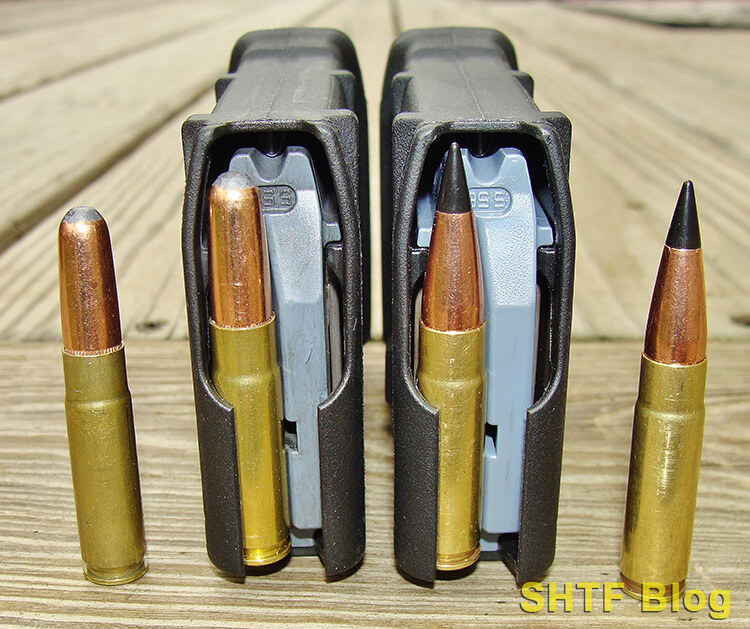
Dual-Load Shooters
Count me among this group. I regularly switch between both loads. Regarding subsonics, Hornady’s 190-grain SUB-X runs fine in all three of my ARs while eliminating expansion concerns. It’s also extremely quiet when suppressed, with zero muzzle flash – just the ticket for nocturnal predators using night-vision.
But it’s still loopy, so 125 yards is my outer limit. The easy but somewhat noisier fix for more range a supersonic load. A switch to 110-grain supersonics even ups the ante to deer. Driven to 2350 fps, these bullet stretch the Blackout’s useful range to around 200 yards.
Still, optimized performance requires the “right” barrel, determined through several details.
Consider Barrel Details
My .300 Blackout experience began with a 16” upper receiver, assembled with a manufacturer for R&D purposes. I wound up ordering the barrel from an outside source prior to this project and, to our surprise, it ran great from the moment it left the workbench. This was nearly ten years ago, when the .300 Blk was less popular and ammo was scarce.
I resorted to handloads created from reformed .223 cases, but the upper still ate everything – atop an existing 5.56 lower receiver no less (so much for pickiness)! Nowadays, this upper resides on its own dedicated lower, and its diet is much more diverse, but it still runs reliably with everything from slow 220-grain subs to zippy 110-grain spitzers.
Configurations
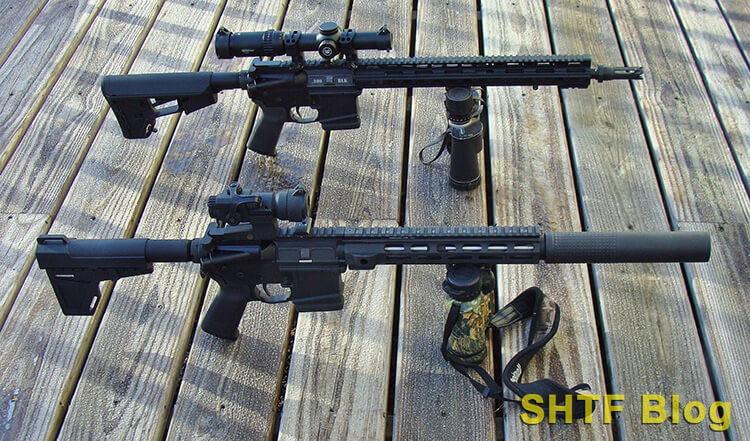
The above AR-15 carbine is probably representative of many .300 Blackouts. Its barrel utilizes a 7” carbine-length gas system, a 1:8 twist, and a 5/8×24 threaded muzzle. This configuration is good all-around choice, (similar to the military M-4), which manages to wring the full potential out of the relatively small cartridge.
Comparable barrels include:
- Jacob Grey Custom .300 Blackout (in 16″)
- Spikes Tactical Medium Profile .300 AAC
- Yankee Hill Machine .300 AAC Blackout Fluted
But so-called AR-15 Pistols are also increasingly popular – especially when used with a suppressor. They’re a way to circumvent the NFA red tape associated with short-barreled rifles (SBRs).
Equipped with a “can”, the overall length of my 10 ½” pistol is no longer than a 16” carbine.
Comparable barrels include:
- Jacob Grey Custom .300 Blackout (in 10″)
- Rosco Manufacturing Purebred (10.5″ and 1:7 twist)
- Spikes Tactical .300 Blackout (8.3″ and 1:8 twist)
It also functions perfectly thanks to its 4” pistol-length gas system, without giving up much velocity. Accuracy is as good too with a caveat: its 1:8 twist doesn’t play well with slow heavy bullets.

Accuracy & Rifling Twists
Normal .30-caliber twists run 1:10 to 1:12, but slow heavyweight BLK projectiles need quicker 1:8 (or 1:7) rates to achieve decent accuracy. The increased stability also decreases worries about bullet-yaw, which could result in a suppressor-wrecking baffle strike (read my article on it). I’ve had good luck across the board with 1:8 in a number of 16-inch barrels, but it may not be fast enough to stabilize heavy subsonics – especially in shorter barrels.
Case in point, the above 10 ½” AR-15 pistol. The first series of subsonic 220-grain RN bullets key-holed randomly at 100 yards. I called an immediate cease-fire to prevent suppressor damage while wishing I’d gone with a 1:7 twist. Easy fix though: A switch to Hornady’s shorter and lighter 190 SUB-X produced 5-shot groups a shade above 1 1/2 inches with perfect function. Since expansion was a priority, the crisis was over. But, for those bent on shooting subsonic loads from short barrels, 1:7 could be the safer bet.
These rates are a bit fast for peak accuracy with lighter-weight supersonics, but useful accuracy is attainable. Five-shot groups will probably average 1.5 MOA-ish (1.5 inches at 100 yards), good enough for most purposes.
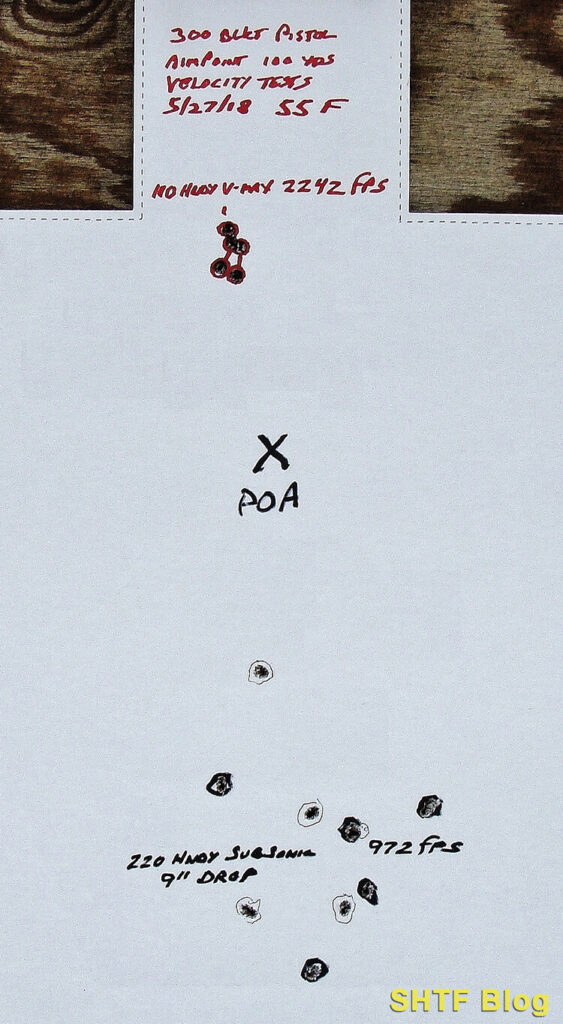
Barrel Length
The Blackout’s relatively small propellant charges, and its larger .30-caliber bore, provide more efficient combustion than a 5.56 – the reason why 16-inches is all that’s really needed.
But where’s the lower limit?
I find 10 ½-inches is a practical compromise, a length that that promotes both function an efficiency. A recent comparison of both lengths provided some interesting chronograph data.
| .300 Blackout Muzz Vel (feet-per-second) | 16” Bbl. | 10 ½” Bbl. | Velocity Loss |
| 110-grain Hornady V-MAX (unsuppressed) | 2350 fps | 2242 fps | 108 fps (5%) |
| 190-grain Hornady SUB-X (suppressed) | 1050 fps | 1025 fps | 25 fps (2.5%) |
Talk about efficiency! Subsonic velocity loss was surprisingly minimal in the 10 ½” barrel, without much additional noise (both suppressed).
Go shorter and, at some point, blast and flash will increase. Function could be compromised as well. The extra backpressure of a suppressor can also increase receiver-related gas blast.
Muzzle Threads
Assuming you reside in a locale where a threaded muzzle is acceptable, the standard .30-caliber 5/8×24 thread pattern will accommodate a flash hider and/or a suppressor. Example: Using seven QD YHM Phantom adapters, my single YHM .30-caliber suppressor sees use on five Blackouts, an HB .308 bolt-action, and a .223 AR-15.
Works great too, the only concern being, the 1/2×28 .223 needs an adapter with a .30-caliber hole!
Suppressor Factors
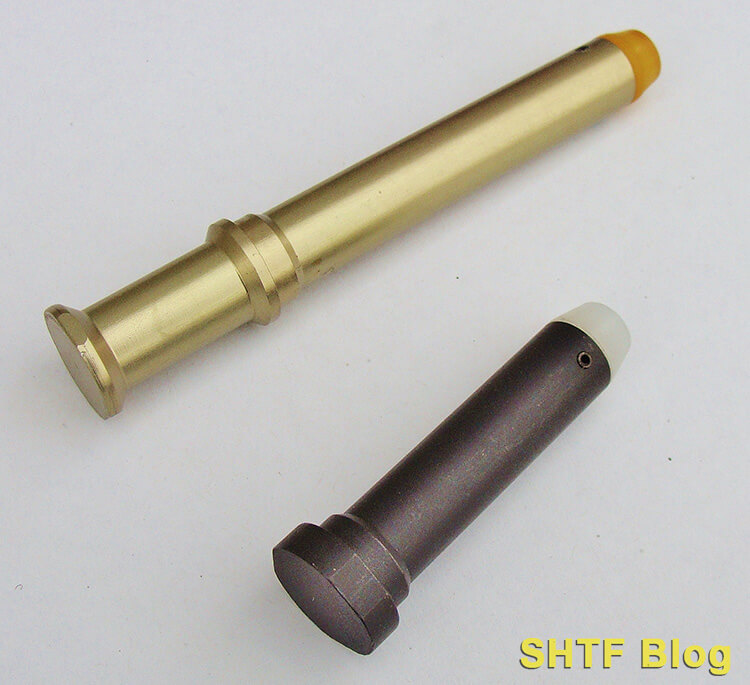
Subsonics might not develop enough pressure to run an AR-15 without a suppressor. But some can be fussy either way. That’s why you’ll see 16” barrels listed with shorter pistol-length gas systems (often rifled 1:7).
The resulting additional pressure helps drive the action. Still, some buffer tinkering could be necessary to include use of a lighter type. An adjustable gas-block offers a further way to fine-tune function for a preferred load.
Also, point-of-impact (POI) can shift through installation of a suppressor. My first carbine has a fairly light M-4 contour, and although it runs and shoots everything well, POI shifts nearly 4-moa when the can is spun on. Two other heavier-barreled AR-15s don’t weigh much more overall (thanks to their .30-caliber bores), but the extra stiffness reduces POI shifts to under 1-MOA. These are, of course, non-issues with a dedicated upper.
FYI, you can shoot supersonics through a suppressor, but they’ll be louder due to the unavoidable sonic crack. Also, these fast loads will show significant POI differences from ambling subsonics!
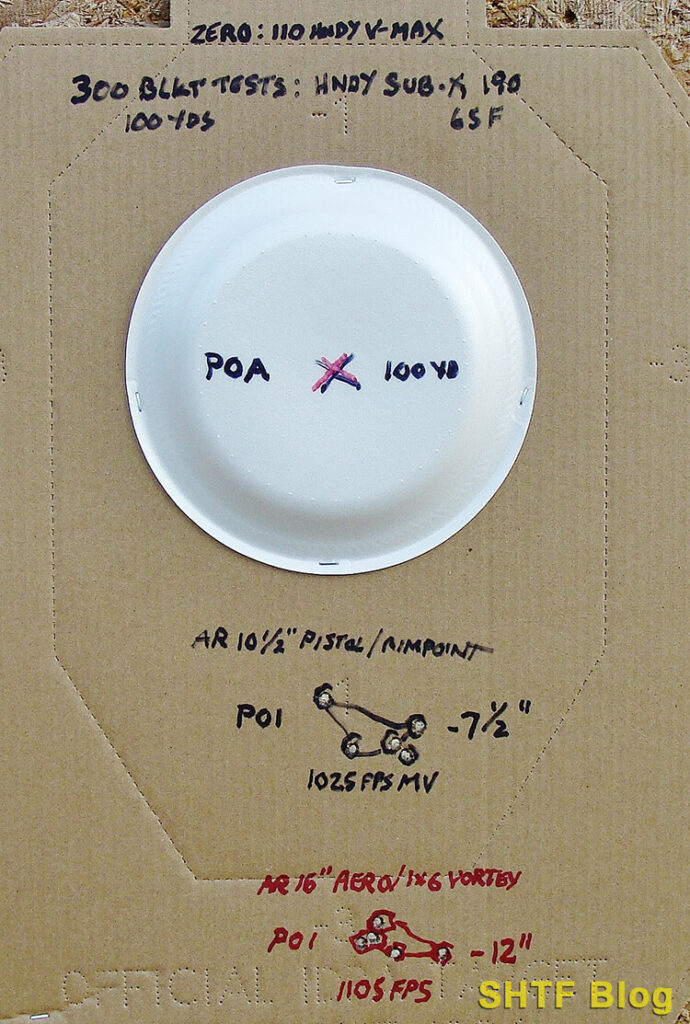
Quality
The one function issue I encountered – intermittent last-shot lock-back failure – was quickly diagnosed by my trusted Armorer, Mike. The cause was an off-center gas port, easily fixed through a minor rotation of the gas block (fortunately a set-screw version).
The AR-15 had been assembled as a “build” from a familiar source, using a supposedly accurate barrel produced offshore, and procured “on sale”. It shot well (still does), but the savings were rapidly consumed by replacement buffers and extra ammo.
I asked Mike about his barrel preferences. He’s had good luck with several sold through Brownells (the source for two of mine). Considering the importance of properly designed feed-ramps, gas ports, etc. there’s no point in skimping on price.
Brownells offers many different .300 AAC Blackout barrels to choose from.
Pitfalls
Caliber mix-ups are a concern for those of us who own 5.56/.223 AR-15s. Thus, a “.300 BLK” dust cover and distinctive magazines are worthwhile insurance.
Another concern is legality. A barrel shorter than 16” must be mounted to a pistol lower. If not, it’ll become an SBR, subject to registration per NFA requirements (like a suppressor) – the reason, my 10 ½” AR-15 started out as a pistol. That’s where it’ll stay, too!
Parting Shots
Both aspects of the Blackout have their own unique rewards. Quiet shooting is just one. As for supersonics, if you’re wondering about the use of heavier bullets, they can certainly be used, possibly with some improvement in accuracy. I stick with lightweight 110s because they shoot flatter and can still perform – with planning.
Hornady’s 110 V-MAX hammers large predators. Barnes solid-copper TACT-TX (or Hornady’s GMX) bullets will reliably expand and penetrate beyond their weight. They’re tough enough to handle deer (or probably hogs) and, being longer than lead types, they tend to shoot well in the Blackout’s faster twists.
That was the route my friend took, using a separate unsuppressed 16” .300 Blackout upper. He just dropped it on to the lower receiver of his existing 5.56 AR-15, slipped its telescoping stock in a notch, and watched as his son tag his first deer.
Finally, this link contains more information about useful .300 Blackout loads in both categories; sub and supersonic: .300 Blackout Hunting Ammunition.
